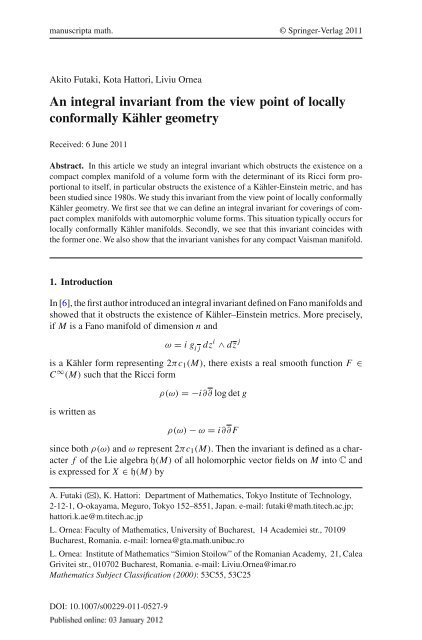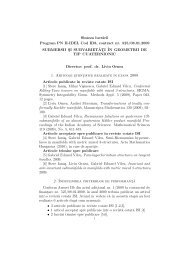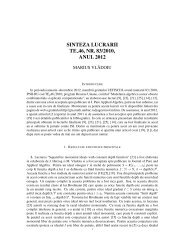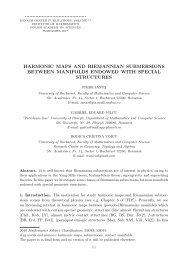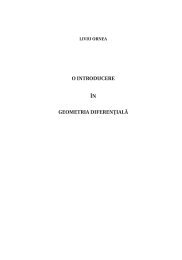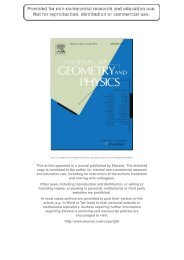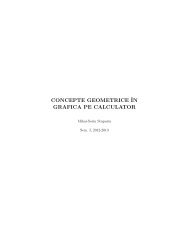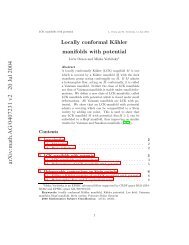An integral invariant from the viewpoint of locally conformally ...
An integral invariant from the viewpoint of locally conformally ...
An integral invariant from the viewpoint of locally conformally ...
You also want an ePaper? Increase the reach of your titles
YUMPU automatically turns print PDFs into web optimized ePapers that Google loves.
manuscripta math. © Springer-Verlag 2011<br />
Akito Futaki, Kota Hattori, Liviu Ornea<br />
<strong>An</strong> <strong>integral</strong> <strong>invariant</strong> <strong>from</strong> <strong>the</strong> view point <strong>of</strong> <strong>locally</strong><br />
<strong>conformally</strong> Kähler geometry<br />
Received: 6 June 2011<br />
Abstract. In this article we study an <strong>integral</strong> <strong>invariant</strong> which obstructs <strong>the</strong> existence on a<br />
compact complex manifold <strong>of</strong> a volume form with <strong>the</strong> determinant <strong>of</strong> its Ricci form proportional<br />
to itself, in particular obstructs <strong>the</strong> existence <strong>of</strong> a Kähler-Einstein metric, and has<br />
been studied since 1980s. We study this <strong>invariant</strong> <strong>from</strong> <strong>the</strong> view point <strong>of</strong> <strong>locally</strong> <strong>conformally</strong><br />
Kähler geometry. We first see that we can define an <strong>integral</strong> <strong>invariant</strong> for coverings <strong>of</strong> compact<br />
complex manifolds with automorphic volume forms. This situation typically occurs for<br />
<strong>locally</strong> <strong>conformally</strong> Kähler manifolds. Secondly, we see that this <strong>invariant</strong> coincides with<br />
<strong>the</strong> former one. We also show that <strong>the</strong> <strong>invariant</strong> vanishes for any compact Vaisman manifold.<br />
1. Introduction<br />
In [6], <strong>the</strong> first author introduced an <strong>integral</strong> <strong>invariant</strong> defined on Fano manifolds and<br />
showed that it obstructs <strong>the</strong> existence <strong>of</strong> Kähler–Einstein metrics. More precisely,<br />
if M is a Fano manifold <strong>of</strong> dimension n and<br />
ω = igij dz i ∧ dz j<br />
is a Kähler form representing 2πc1(M), <strong>the</strong>re exists a real smooth function F ∈<br />
C ∞ (M) such that <strong>the</strong> Ricci form<br />
is written as<br />
ρ(ω) =−i∂∂ log det g<br />
ρ(ω) − ω = i∂∂ F<br />
since both ρ(ω) and ω represent 2πc1(M). Then <strong>the</strong> <strong>invariant</strong> is defined as a character<br />
f <strong>of</strong> <strong>the</strong> Lie algebra h(M) <strong>of</strong> all holomorphic vector fields on M into C and<br />
is expressed for X ∈ h(M) by<br />
A. Futaki (B), K. Hattori: Department <strong>of</strong> Ma<strong>the</strong>matics, Tokyo Institute <strong>of</strong> Technology,<br />
2-12-1, O-okayama, Meguro, Tokyo 152–8551, Japan. e-mail: futaki@math.titech.ac.jp;<br />
hattori.k.ae@m.titech.ac.jp<br />
L. Ornea: Faculty <strong>of</strong> Ma<strong>the</strong>matics, University <strong>of</strong> Bucharest, 14 Academiei str., 70109<br />
Bucharest, Romania. e-mail: lornea@gta.math.unibuc.ro<br />
L. Ornea: Institute <strong>of</strong> Ma<strong>the</strong>matics “Simion Stoilow” <strong>of</strong> <strong>the</strong> Romanian Academy, 21, Calea<br />
Grivitei str., 010702 Bucharest, Romania. e-mail: Liviu.Ornea@imar.ro<br />
Ma<strong>the</strong>matics Subject Classification (2000): 53C55, 53C25<br />
DOI: 10.1007/s00229-011-0527-9
f (X) =<br />
M<br />
A. Futaki et al.<br />
XFω n . (1)<br />
This <strong>invariant</strong> was later extended in various ways. We first briefly review <strong>the</strong> various<br />
extensions.<br />
The first line <strong>of</strong> extension is as <strong>invariant</strong>s for compact Kähler manifolds with<br />
fixed Kähler class. Let (M, [ω]) be a compact Kähler manifold M with a Kähler<br />
class [ω]. Then we can extend f as an obstruction to <strong>the</strong> existence <strong>of</strong> a Kähler form<br />
in [ω] <strong>of</strong> constant scalar curvature ([7], [2]). This is defined by <strong>the</strong> same formula<br />
(1) if we replace <strong>the</strong> condition <strong>of</strong> F by<br />
<br />
σ − σω n /vol(M) = F<br />
M<br />
where σ denotes <strong>the</strong> scalar curvature <strong>of</strong> ω. When [ω] is an <strong>integral</strong> class this was<br />
fur<strong>the</strong>r reformulated by Donaldson [3] as an <strong>invariant</strong> for polarized schemes, and<br />
was used to define <strong>the</strong> notion <strong>of</strong> K-stability. In a guise <strong>the</strong> reformulated <strong>invariant</strong><br />
was expressed as slopes for subschemes by Ross and Thomas [17]. For Fano manifolds<br />
with <strong>the</strong> anticanonical class, <strong>the</strong> <strong>invariant</strong> f has recently been extended to<br />
an obstruction to <strong>the</strong> existence <strong>of</strong> Kähler–Einstein metrics with cone singularities<br />
along a divisor (Donaldson [4], Li [14]), and it is used to define logarithmic K-stability.<br />
Around <strong>the</strong> same time as <strong>the</strong> work [7] and [2], <strong>the</strong> <strong>invariant</strong> f obstructing<br />
<strong>the</strong> constant scalar curvature Kähler metric was extended fur<strong>the</strong>r by Bando [1]toa<br />
family <strong>of</strong> <strong>invariant</strong>s fk, k = 1, ··· , n, where fk obstructs <strong>the</strong> existence <strong>of</strong> a Kähler<br />
form in [ω] such that <strong>the</strong> kth Chern form ck(ω) is harmonic. Notice that <strong>the</strong> scalar<br />
curvature is constant if and only if <strong>the</strong> first Chern form is harmonic by <strong>the</strong> second<br />
Bianchi identity. Thus f1 coincides with f . Bando’s idea can be fur<strong>the</strong>r extended<br />
to transverse Kähler geometry <strong>of</strong> compact Sasaki manifolds [12].<br />
The second line <strong>of</strong> extension was obtained in [10], but this extension is obtained<br />
by relating <strong>the</strong> <strong>invariant</strong> f for Fano manifolds to <strong>invariant</strong>s classically known in<br />
<strong>the</strong> <strong>the</strong>ory <strong>of</strong> <strong>the</strong> equivariant cohomology. Again, let M be a Fano manifold and<br />
ω = igij dzi ∧dz j is a Kähler form representing 2πc1(M). By <strong>the</strong> solution by Yau<br />
[20] to <strong>the</strong> Calabi conjecture, <strong>the</strong>re exists a Kähler form η representing 2πc1(M)<br />
such that ρ(η) = ω. Then we can rewrite f as in (1) in terms <strong>of</strong> η and obtain<br />
<br />
f (X) = divX ρ(η) n<br />
(2)<br />
where<br />
M<br />
divX · η n = ∂i(X)η n<br />
and i(X) denotes <strong>the</strong> interior product by X,see[10]or[8] for <strong>the</strong> detail. Note that,<br />
instead <strong>of</strong> <strong>the</strong> Kähler form η, we may use any volume form and its Ricci form<br />
ρ() =−i∂∂ log .<br />
(3)
Kähler geometry<br />
Then we may write (2)as<br />
where<br />
<br />
f (X) = divX ρ() n<br />
M<br />
(4)<br />
divX · = ∂i(X). (5)<br />
We can prove that f is <strong>the</strong>n independent <strong>of</strong> <strong>the</strong> choice <strong>of</strong> , and thus we do not need<br />
to assume that M is Fano or Kähler. Thus we obtained an <strong>invariant</strong> for (possibly<br />
non-Kähler) complex manifolds. This last <strong>invariant</strong> is <strong>the</strong> one we wish to study in<br />
this paper. Note also that we can rewrite (4) as<br />
<br />
ρ() n <br />
f (X) =− X . (6)<br />
<br />
M<br />
Therefore <strong>the</strong> <strong>invariant</strong> f is an obstruction to <strong>the</strong> existence <strong>of</strong> a volume form <br />
such that ρ() n / is constant.<br />
We remark in passing that <strong>the</strong>re is a larger family <strong>of</strong> <strong>invariant</strong>s including <strong>the</strong>se<br />
two lines <strong>of</strong> extension ([9]). Among <strong>the</strong>m we have a family <strong>of</strong> <strong>invariant</strong>s which<br />
obstructs asymptotic Chow semistability <strong>of</strong> polarized manifolds ([9], [11]). By<br />
computing <strong>the</strong>m for a 7-dimensional toric Fano manifold suggested by Nill and Paffenholz<br />
[15], Ono, Sano and Yotsutani [16] showed that <strong>the</strong>re is a Kähler-Einstein<br />
Fano manifold which is asymptotically unstable.<br />
Now let us turn to <strong>the</strong> study <strong>of</strong> <strong>the</strong> <strong>invariant</strong> defined by (4) or(6). Let M be a<br />
compact connected complex manifold <strong>of</strong> dimension n. Consider a covering space<br />
π : M → M with <strong>the</strong> group Ɣ <strong>of</strong> <strong>the</strong> deck transformations, and let χ : Ɣ → R + be<br />
a homomorphism. A volume form on M is said to be automorphic with respect<br />
to χ if, for any γ ∈ Ɣ,<br />
γ ∗ = χ(γ). (7)<br />
Such a covering with automorphic volume form naturally occurs for <strong>locally</strong> <strong>conformally</strong><br />
Kähler manifolds as we shall see in <strong>the</strong> next section.<br />
Given such a covering M with automorphic volume form with respect to χ we<br />
have a Ricci form ρ <strong>of</strong> defined on M by<br />
ρ =−i∂∂ log . (8)<br />
Since is automorphic, ρ is <strong>invariant</strong> under <strong>the</strong> action <strong>of</strong> Ɣ, and thus descends<br />
to a 2-form on M which is denoted by <strong>the</strong> same notation ρ. This represents <strong>the</strong><br />
first Chern class 2πc1(M), and also 2πc1( M) upstairs if M is compact.<br />
Denote by h(M) and h( M) <strong>the</strong> Lie algebras <strong>of</strong> all holomorphic vector fields on<br />
M and M respectively. Denote also by hƔ( M) <strong>the</strong> Lie subalgebra <strong>of</strong> h( M) consisting<br />
<strong>of</strong> all holomorphic vector fields on M which are <strong>invariant</strong> under <strong>the</strong> action <strong>of</strong> Ɣ.<br />
Then a holomorphic vector field in hƔ( M) descends to a holomorphic vector field
A. Futaki et al.<br />
on M, and thus hƔ( M) can be naturally regarded as a Lie subalgebra <strong>of</strong> h(M).For<br />
an X in hƔ( M), its divergence divX is defined by<br />
divX · = ∂i(X) (9)<br />
where i(X) denotes <strong>the</strong> interior product by X. Since is automorphic and X is<br />
<strong>invariant</strong> under Ɣ it follows that divX is <strong>invariant</strong> under Ɣ and that divX descends<br />
to a smooth function on M.<br />
We define a linear function f : hƔ( M) → C by<br />
<br />
f (X) = divX ρ n . (10)<br />
The main <strong>the</strong>orem <strong>of</strong> this article is <strong>the</strong> following.<br />
M<br />
Theorem 1.1. (a) Let M be a compact connected complex manifold and M its<br />
covering space with <strong>the</strong> group Ɣ <strong>of</strong> deck transformations. Suppose that we are given<br />
a character χ : Ɣ → R + . Then f is independent <strong>of</strong> <strong>the</strong> choice <strong>of</strong> <strong>the</strong> volume form<br />
automorphic with respect to χ.(b) The <strong>invariant</strong>s defined by (4) and (10) coincide.<br />
This implies, in particular, that <strong>the</strong> <strong>invariant</strong> defined by (10) is independent<br />
<strong>of</strong> choice <strong>of</strong> χ.<br />
A <strong>locally</strong> <strong>conformally</strong> Kähler manifold (M, J, g) is said to be a Vaisman manifold<br />
if <strong>the</strong>re is a metric in <strong>the</strong> conformal class <strong>of</strong> g for which <strong>the</strong> Lee form is parallel,<br />
see Sect. 2 for more detail.<br />
Theorem 1.2. The <strong>invariant</strong> in <strong>the</strong> previous <strong>the</strong>orem vanishes for any compact<br />
Vaisman manifold.<br />
This article is organized as follows. In Sect. 2 we summarize <strong>the</strong> basics <strong>of</strong><br />
<strong>locally</strong> <strong>conformally</strong> Kähler geometry, and give a pro<strong>of</strong> <strong>of</strong> Theorem 1.2. In Sect. 3<br />
we give a pro<strong>of</strong> <strong>of</strong> Theorem 1.1. In Sect. 4 we compute <strong>the</strong> <strong>invariant</strong> for <strong>the</strong> one<br />
point blow-up <strong>of</strong> <strong>the</strong> Hopf surface, and see that this surface gives an example <strong>of</strong><br />
nontrivial <strong>invariant</strong>.<br />
2. Locally <strong>conformally</strong> Kähler manifolds<br />
Let (M, J) be a connected complex manifold <strong>of</strong> complex dimension n ≥ 2 with<br />
J a complex structure. A <strong>locally</strong> <strong>conformally</strong> Kähler structure (LCK structure for<br />
short) on (M, J) is a covering<br />
Ɣ → ( M, J, ω) → (M, J)<br />
where M is a covering space <strong>of</strong> M, ω a Kähler form on M, and Ɣ <strong>the</strong> group <strong>of</strong><br />
deck transformations acting on M as holomorphic homo<strong>the</strong>ties. Thus <strong>the</strong>re is a<br />
homomorphism χ : Ɣ → R + satisfying<br />
γ ∗ ω = χ(γ)ω.
Kähler geometry<br />
A p-form α on M is said to be automorphic with respect to λ if γ ∗ α = λ(γ )α<br />
for some character λ : Ɣ → R + . The above Kähler form ω is an example <strong>of</strong> an<br />
automorphic 2-form.<br />
There is an equivalent definition <strong>of</strong> an LCK structure described as follows. <strong>An</strong><br />
LCK structure is a collection <strong>of</strong> an open covering M =∪α∈Uα and Kähler metrics<br />
gα on Uα satisfying<br />
gα = cαβ gβ<br />
on Uα ∩ Uβ with cαβ ∈ R+. Then {cαβ} gives a cocycle. Let θ be a representative<br />
as a closed one form defining <strong>the</strong> same cohomology class as {log cαβ}. Thus<br />
we have dθ = 0, and <strong>locally</strong> θ|Uα = dfα for a smooth function fα on Uα with<br />
fβ − fα = log cαβ and e fα gα = e fβ gβ on Uα ∩ Uβ. Therefore g := e fα gα defines<br />
a global Hermitian metric <strong>locally</strong> conformal to a Kähler metric. The 1-form θ is<br />
called <strong>the</strong> Lee form. Let ω be <strong>the</strong> fundamental 2-form defined by<br />
Then one easily shows that<br />
ω(X, Y ) = g(JX, Y ).<br />
dω = θ ∧ ω (11)<br />
dθ = 0. (12)<br />
As an equivalent third definition we may say that an Hermitian manifold (M, J, g)<br />
is a <strong>locally</strong> <strong>conformally</strong> Kähler manifold if <strong>the</strong> fundamental 2-form ω <strong>of</strong> g satisfies<br />
(11) and (12) (seee.g.[5]).<br />
Remark 2.1. When we say (M, J, g) is an LCK manifold we assume that θ = 0,<br />
that is, (M, J, g) is not globally Kähler.<br />
The equivalence between <strong>the</strong> second and <strong>the</strong> third definitions is obvious. To see<br />
that first implies <strong>the</strong> third, suppose that we are in a situation <strong>of</strong> <strong>the</strong> first definition.<br />
Let L be <strong>the</strong> R-bundle given by M ×χ R. Since χ is R + -valued, L is oriented and<br />
thus is a trivial bundle. It follows that L has a nowhere zero section which defines a<br />
positive χ-equivariant function φ on M. Then ω := φ −1 ω is a Ɣ-<strong>invariant</strong> positive<br />
2-form. This ω satisfies <strong>the</strong> third definition with θ =−log φ.<br />
We need only to show that <strong>the</strong> second implies <strong>the</strong> first. Suppose that we have<br />
Kähler forms ωα on Uα such that ωα = cαβωβ with cαβ ∈ R + . Then {cαβ}∈<br />
H 1 (M, R +δ ) defines a flat principal R + -bundle. The holonomy gives a character<br />
χ : Ɣ = π1(M) → R + .LetL = M ×χ R be <strong>the</strong> associated R-bundle. We may<br />
regard {ωα} as a section <strong>of</strong><br />
L ⊗ 2 T ∗ M = ( M ×χ R) ⊗ 2 T ∗ M = M ×χ (R ⊗ p ∗ 2 T ∗ M)<br />
where p : M → M is <strong>the</strong> projection. Thus {ωα} defines a χ-equivariant closed<br />
2-form ω on M. This completes <strong>the</strong> equivalence <strong>of</strong> <strong>the</strong> three definitions <strong>of</strong> LCK<br />
structures.
A. Futaki et al.<br />
Pro<strong>of</strong> <strong>of</strong> Theorem 1.2. Recall that a <strong>locally</strong> <strong>conformally</strong> Kähler manifold (M, J, g)<br />
is said to be a Vaisman manifold if <strong>the</strong>re is a metric in <strong>the</strong> conformal class <strong>of</strong> g<br />
for which <strong>the</strong> Lee form is parallel. It is shown in [13] that a Vaisman manifold<br />
is obtained as a quotient <strong>of</strong> <strong>the</strong> Kähler cone C(S) <strong>of</strong> a Sasakian manifold S by a<br />
subgroup Ɣ <strong>of</strong> <strong>the</strong> homo<strong>the</strong>ties acting freely and properly discontinuously. Then<br />
<strong>the</strong> pro<strong>of</strong> follows <strong>from</strong> Lemma 2.2 below since for <strong>the</strong> Reeb vector field ξ = Jr ∂<br />
∂r<br />
on C(S), ξ − iJξ generates a holomorphic flow and <strong>the</strong> Ricci tensor degenerates<br />
on this orbit. See <strong>the</strong> arguments below for <strong>the</strong> notations.<br />
Recall that a Riemannian manifold (S, g) <strong>of</strong> dimension 2m + 1 is a Sasakian<br />
manifold if <strong>the</strong> cone (C(S), ¯g) = (R + × S, dr2 + r 2g) is a Kähler manifold. Here<br />
r is <strong>the</strong> standard coordinate on R + . The metric ¯g is a warped product metric, and<br />
<strong>the</strong> Riemannian geometry <strong>of</strong> C(S) is easily studied <strong>from</strong> that <strong>of</strong> S. Let¯∇ and ∇<br />
be <strong>the</strong> Levi-Civita connections on C(S) and S respectively. Let X, Y be tangent<br />
vector fields on S, which are naturally regarded as vector fields on C(S) by <strong>the</strong><br />
product structure C(S) = R + × S. Consider a vector field := r ∂<br />
∂r on C(S).Itis<br />
generally true for cone manifolds that<br />
and that<br />
¯∇X = ¯∇ X = X (13)<br />
¯∇X Y =∇X Y − g(X, Y ). (14)<br />
Let ¯R be <strong>the</strong> curvature tensors on C(S). Then using (13) and (14) we obtain<br />
¯R(X,,Y,) =¯g(− ¯∇X ¯∇Y + ¯∇ ¯∇X Y + ¯∇[X,]Y,<br />
=¯g(− ¯∇X Y + ¯∇(∇X Y − g(X, Y )), )<br />
=−¯g(∇X Y − g(X, Y ), ) +¯g(∇X Y − g(X, Y ), )<br />
= 0.<br />
This implies that<br />
¯Ric(, ) = 0 (15)<br />
where ¯Ric denotes <strong>the</strong> Ricci tensor on C(S).<br />
Let J be <strong>the</strong> complex structure on C(S). The vector field ξ = Jr ∂<br />
∂r on C(S)<br />
is called <strong>the</strong> Reeb vector field, and it is a standard fact in Sasakian geometry that<br />
ξ − iJξ is a holomorphic vector field. Since <strong>the</strong> Ricci tensor on a Kähler manifold<br />
is J-<strong>invariant</strong>, (15) implies<br />
From (15) and (16) we have proved <strong>the</strong> following.<br />
¯Ric(ξ, ξ) = 0. (16)<br />
Lemma 2.2. The Ricci tensor on C(S) vanishes on <strong>the</strong> plane spanned by ξ and<br />
Jξ =−r ∂<br />
∂r .
Kähler geometry<br />
For a Vaisman manifold M we can also find an LCK metric g for which <strong>the</strong> Ricci<br />
form ρ(g) satisfies ρ(g) n = 0, showing that <strong>the</strong> integrand <strong>of</strong> (4) and (6) vanishes.<br />
Recall that <strong>the</strong> Kähler form ω on C(S) is written as ω = dd c r 2 , see for example<br />
[12]. As we have seen in Lemma 2.2,wehaveρ(ω) m+1 = 0. Note that n = m + 1<br />
here. Then ω/r 2 = 1<br />
r 2 dd c r 2 defines a Ɣ-<strong>invariant</strong> 2-form and descends to M. Since<br />
dd c log r is <strong>the</strong> transverse Kähler form ω T on <strong>the</strong> Sasaki manifold S (but regarded<br />
as lifted to C(S)), <strong>the</strong> Ricci form <strong>of</strong> ω/r 2 is equal to ρ(ω) + 2(m + 1)ω T .This<br />
also degenerates on <strong>the</strong> orbit <strong>of</strong> <strong>the</strong> flow generated by ξ − iJξ. Hence we have<br />
ρ(ω/r 2 ) m+1 = 0 on <strong>the</strong> Vaisman manifold M.<br />
3. Pro<strong>of</strong> <strong>of</strong> Theorem 1.1<br />
In this section we prove <strong>the</strong> following result.<br />
Theorem 3.1. Let M be a compact connected complex manifold and M its covering<br />
space with <strong>the</strong> group Ɣ <strong>of</strong> deck transformations. Suppose that we are given a<br />
character χ : Ɣ → R + . Then f defined by (10) is independent <strong>of</strong> <strong>the</strong> choice <strong>of</strong> <strong>the</strong><br />
automorphic volume form and its character χ.<br />
Theorem 1.1 follows <strong>from</strong> Theorem 3.1 because (a) in Theorem 1.1 is obtained<br />
by comparing (1,χ)and (2,χ), and (b) in Theorem 1.1 is obtained by comparing<br />
(1,χ)and (2, 1).<br />
Let M be a compact connected complex manifold and M be a covering space<br />
<strong>of</strong> M with <strong>the</strong> group Ɣ <strong>of</strong> deck transformations. Let be a smooth volume form on<br />
M automorphic with respect to χ : Ɣ → R + .Ifz 1 , ··· , z n are local holomorphic<br />
coordinates on M, <strong>the</strong>volumeform can be expressed as<br />
= aidz 1 ∧ dz 1 ∧···∧idz n ∧ dz n<br />
(17)<br />
where a is a local positive smooth function. The Ricci form ρ and <strong>the</strong> divergence<br />
divX can be expressed using a as<br />
and<br />
From (19) we obtain<br />
divX =<br />
ρ =−i∂∂ log a, (18)<br />
n<br />
i=1<br />
∂ X i<br />
+ X (log a). (19)<br />
∂zi ∂divX = i(X)∂∂ log a. (20)<br />
Pro<strong>of</strong> <strong>of</strong> Theorem 3.1. Let 0,1 be volume forms automorphic with respect to<br />
χ0,χ1 : Ɣ → R + , respectively. Then i can be expressed as<br />
0 = aidz 1 ∧ dz 1 ∧···∧idz n ∧ dz n ,<br />
1 = ϕaidz 1 ∧ dz 1 ∧···∧idz n ∧ dz n ,
A. Futaki et al.<br />
where <strong>the</strong> positive real valued function ϕ on M is given by 1 = ϕ0. Then we<br />
have<br />
γ ∗ ϕ = χ1(γ )<br />
ϕ (21)<br />
χ0(γ )<br />
for all γ ∈ Ɣ.<br />
Let t be<br />
t = ϕ t aidz 1 ∧ dz 1 ∧···∧idz n ∧ dz n , (22)<br />
for each 0 ≤ t ≤ 1. Then each t is automorphic with respect to a character<br />
χt := χ 1−t<br />
0 χ t 1 . Thus a smooth family <strong>of</strong> linear maps ft : hƔ( M) → C is defined<br />
by<br />
<br />
ft(X) = divt X ρ n t , (23)<br />
M<br />
where divt X is <strong>the</strong> divergence determined by t. Then it suffices to show that<br />
for all X ∈ hƔ( M).<br />
It is easy to see<br />
and<br />
Then we have<br />
<br />
d<br />
divt X · ρ<br />
dt<br />
M<br />
n t<br />
<br />
= X (log ϕ) ρ n t −<br />
<br />
M<br />
<br />
=<br />
M<br />
<br />
−<br />
d<br />
dt ft(X) = 0 (24)<br />
d<br />
dt (divt X) = X (log ϕ) (25)<br />
d<br />
ρt =−i∂∂ log ϕ. (26)<br />
dt<br />
M<br />
X (log ϕ) ρ n t +<br />
<br />
M<br />
M<br />
divt Xi∂∂(log ϕ) ∧ nρ n−1<br />
t<br />
∂(divt X ∧ ∂(i log ϕ) ∧ nρ n−1<br />
t )<br />
∂(divt X) ∧ ∂(i log ϕ) ∧ nρ n−1<br />
. t<br />
Although ϕ may not be Ɣ-<strong>invariant</strong>, ∂ log ϕ is Ɣ-<strong>invariant</strong> <strong>from</strong> (21) and descends<br />
toa1-formonM. Since divt X and ρt are also defined globally on M, we can<br />
deduce
Kähler geometry<br />
<br />
M<br />
<strong>from</strong> Stokes’ Theorem. Therefore we have<br />
<br />
d<br />
dt<br />
divt X · ρ<br />
M<br />
n t<br />
<br />
= X (log ϕ) ρ n t −<br />
<br />
M<br />
<br />
=<br />
M<br />
<br />
=<br />
<br />
−<br />
M<br />
<br />
=<br />
M<br />
M<br />
∂(divt X ∧ ∂(i log ϕ) ∧ nρ n−1<br />
) = 0 (27)<br />
t<br />
X (log ϕ) ρ n t<br />
M<br />
∂(divt X) ∧ ∂(i log ϕ) ∧ nρ n−1<br />
t<br />
(i(X)∂∂ log(ϕ t a)) ∧ ∂(i log ϕ) ∧ nρ n−1<br />
t<br />
X (log ϕ) ρ n t +<br />
<br />
i(X)(ρ n t<br />
M<br />
∧ ∂ log ϕ) = 0<br />
(i(X)ρ n t ) ∧ ∂ log ϕ<br />
since ρn ∧ ∂ log ϕ ≡ 0 because <strong>of</strong> dimension reasons. This completes <strong>the</strong> pro<strong>of</strong><br />
t<br />
<strong>of</strong> Theorem 3.1. ⊓⊔<br />
Remark 3.2. In general <strong>the</strong> vanishing <strong>of</strong> f is <strong>the</strong> obstruction to <strong>the</strong> existence <strong>of</strong> an<br />
automorphic volume form on M with ρ = 0. But if M = M or χ is trivial, <strong>the</strong><br />
vanishing <strong>of</strong> f obstructs <strong>the</strong> existence <strong>of</strong> a volume form with ρn = k for some<br />
constant k.<br />
4. The localization formula and an example<br />
Now that <strong>the</strong> <strong>invariant</strong> is independent <strong>of</strong> <strong>the</strong> choice <strong>of</strong> (, χ) we may use an old<br />
result to compute <strong>the</strong> case when χ is trivial. This is a residue formula for holomorphic<br />
vector fields.<br />
Let X be a holomorphic vector field in h(M). Define a section L(X) <strong>of</strong> <strong>the</strong><br />
endomorphism bundle End(TM) <strong>of</strong> <strong>the</strong> holomorphic tangent bundle TMby<br />
L(X)Y =∇X Y −[X, Y ]. (28)<br />
Suppose that <strong>the</strong> zero set zero(X) <strong>of</strong> X consists <strong>of</strong> smooth submanifolds {Zλ}λ∈.<br />
Then L(X) induces a section L ν (X) <strong>of</strong> <strong>the</strong> endomorphism bundle <strong>of</strong> <strong>the</strong> normal<br />
bundle ν(Zλ) = (TM|Zλ )/TZλ <strong>of</strong> Zλ.
A. Futaki et al.<br />
Theorem 4.1 (Theorem 5.2.8 in [8]). If Lν (X) is nonsingular at every q ∈<br />
zero(X), we have <strong>the</strong> following localization formula<br />
n 1<br />
(n + 1) f (X) =<br />
2π<br />
<br />
<br />
(divX + c1(M)) n+1 <br />
|Zλ / det L ν (X) + i<br />
2π K<br />
<br />
λ<br />
Zλ<br />
where K is <strong>the</strong> curvature form <strong>of</strong> ν(Zλ) with respect to <strong>the</strong> induced Hermitian<br />
connection.<br />
We provide an explicit computation <strong>of</strong> non-zero <strong>invariant</strong> on <strong>the</strong> blow-up at a<br />
point <strong>of</strong> a Hopf surface which by [18,19] is an LCK manifold, using <strong>the</strong> localization<br />
formula.<br />
Let H 2 be a Hopf surface that we regard as C2 \{0}/Z, where Z is generated<br />
by <strong>the</strong> transformation (z1, z2) ↦→ (2z1, 2z2). We choose <strong>the</strong> fundamental domain<br />
on C2 \{0} to be {(z1, z2) | 1 ≤|z1| 2 +|z2| 2 ≤ 2}.<br />
Let M be <strong>the</strong> blow-up <strong>of</strong> H 2 at <strong>the</strong> point (0, 3 2 ). It will be convenient to change<br />
<strong>the</strong> coordinates (z1, z2) into (w1,w2) by:<br />
w1 = z1, w2 = z2 − 3<br />
2 .<br />
Then <strong>the</strong> blow-up takes place at <strong>the</strong> origin (w1,w2) = (0, 0) and <strong>the</strong> exceptional<br />
divisor E is {(w1 : w2)} ∼ = CP 1 ⊂ M.<br />
Let X = z1 ∂<br />
∂z1 be <strong>the</strong> radial (global) vector field on C2 . Its zero set contains<br />
(0, 3 2 ). We shall equally denote by X its lift to M. Its zero set on M will certainly<br />
contain {z1 = 0}, but also some o<strong>the</strong>r point that we now determine.<br />
Take first local coordinates on M around (1 : 0) ∈ E to be<br />
ζ1 = w1, ζ2 = w2<br />
.<br />
This change <strong>of</strong> coordinates is consistent with <strong>the</strong> coordinates on <strong>the</strong> exceptional<br />
divisor. In <strong>the</strong> new coordinates, X is written as<br />
∂ ∂<br />
X = ζ1 − ζ2 .<br />
∂ζ1 ∂ζ2<br />
In <strong>the</strong>se coordinates (ζ1,ζ2), zero(X) = {(0, 0)} . Hence, <strong>the</strong> zero is on E (as<br />
ζ1 = 0). On <strong>the</strong> o<strong>the</strong>r hand, ζ2 = 0 implies w2 = 0. Thus, <strong>the</strong> isolated zero <strong>of</strong> X<br />
is (w1 : w2) = (1 : 0).<br />
Now recall that, in general, if a holomorphic vector field Y = a ∂ ∂<br />
+b , <strong>the</strong>n<br />
∂ζ1 ∂ζ2<br />
L(Y )( ∂<br />
∂ ∂<br />
)|zero(Y ) =−LY +∇X =<br />
∂ζj<br />
∂ζj ∂ζj<br />
∂a ∂<br />
+<br />
∂ζj ∂ζ1<br />
∂b ∂<br />
, (29)<br />
∂ζj ∂ζ2<br />
as <strong>the</strong> ∇Y = 0 on <strong>the</strong> zero set <strong>of</strong> Y .<br />
Hence, in our case, for <strong>the</strong> point (1 : 0), <strong>the</strong> localization formula reduces to:<br />
tr(L(X)) 3<br />
det(L ν (X)) =<br />
3 1 0<br />
tr<br />
0 −1<br />
= 0,<br />
1 0<br />
det<br />
0 −1<br />
w1
Kähler geometry<br />
as <strong>the</strong> normal bundle <strong>of</strong> <strong>the</strong> point equals <strong>the</strong> tangent bundle at <strong>the</strong> point, and this is<br />
trivial, hence = 0.<br />
So, <strong>the</strong> isolated zero does not contribute to <strong>the</strong> value <strong>of</strong> <strong>the</strong> <strong>invariant</strong>.<br />
For <strong>the</strong> dimension 1 component <strong>of</strong> zero(X), takeonM, around (0 : 1), <strong>the</strong><br />
coordinates:<br />
ζ1 = w2, ζ2 = w1<br />
.<br />
In <strong>the</strong>se coordinates X takes <strong>the</strong> form<br />
∂<br />
X = ζ2 ,<br />
∂ζ2<br />
and zero(X) = {(ζ1, 0)}, a line represented by (0 : 1). It is <strong>the</strong> proper transform <strong>of</strong><br />
{z1 = 0}.Using(29), we find now<br />
<br />
00<br />
L(X) = .<br />
01<br />
The localization formula gives:<br />
<br />
Z<br />
<br />
tr<br />
<br />
00<br />
01<br />
1 +<br />
+<br />
√<br />
−1<br />
2π <br />
3 √ −1<br />
2π ν<br />
<br />
=<br />
Z<br />
w2<br />
(1 + c1(Z) + c1(ν(Z))) 3<br />
,<br />
1 + c1(ν(Z))<br />
where ν(Z) is <strong>the</strong> normal bundle <strong>of</strong> <strong>the</strong> zero set Z = zero(X).<br />
Observe that ν(Z) = −[E]. Indeed, if π : M → H 2 denotes <strong>the</strong> natural<br />
projection, <strong>the</strong>n:<br />
[π(Z)] =[π(Z + E)],<br />
and hence (as <strong>the</strong>y are trivial line bundles),<br />
0 = π ∗ [π(Z)] =[Z + E] =[Z]+[E] =[ν(Z)]+[E].<br />
On <strong>the</strong> o<strong>the</strong>r hand, c1(Z) = 0, as Z is an elliptic curve. We obtain:<br />
<br />
(1 + c1(Z) + c1(ν(Z)))<br />
Z<br />
3 <br />
= (1 − c1([E]))<br />
1 + c1(ν(Z))<br />
Z<br />
3 (1 + c1([E])))<br />
<br />
= (−3c1([E])) + c1([E])))<br />
In conclusion, 3( 1<br />
2π )2 f (X) =−2 = 0.<br />
Z<br />
= Z · (−2[E])) =−2.<br />
Acknowledgements. Liviu Ornea thanks Tokyo Institute <strong>of</strong> Technology for hospitality during<br />
part <strong>of</strong> <strong>the</strong> preparation <strong>of</strong> this study.
References<br />
A. Futaki et al.<br />
[1] Bando, S.: <strong>An</strong> obstruction for Chern class forms to be harmonic. Kodai Math.<br />
J. 29, 337–345 (2006)<br />
[2] Calabi, E.: Extremal Kähler metrics II. In: Chavel, I., Farkas, H.M. (eds.) Differential<br />
geometry and complex analysis, pp. 95–114. Springer-Verlag, Berlin (1985)<br />
[3] Donaldson, S.K.: Scalar curvature and stability <strong>of</strong> toric varieties. J. Differ.<br />
Geom. 62, 289–349 (2002)<br />
[4] Donaldson, S.K.: Kähler metrics with cone singularities along a divisor, preprint.<br />
arXiv:1102.1196<br />
[5] Dragomir, S., Ornea, L.: Locally conformal Kähler geometry, progress in ma<strong>the</strong>matics,<br />
vol. 155. Birkhäuser, Boston (1998)<br />
[6] Futaki, A.: <strong>An</strong> obstruction to <strong>the</strong> existence <strong>of</strong> Einstein Kähler metrics. Invent.<br />
Math. 73, 437–443 (1983)<br />
[7] Futaki, A.: On compact Kähler manifolds <strong>of</strong> constant scalar curvature. Proc. Jpn. Acad.<br />
A 59, 401–402 (1983)<br />
[8] Futaki, A.: Kähler–Einstein metrics and <strong>integral</strong> <strong>invariant</strong>s. Lecture notes in ma<strong>the</strong>matics,<br />
vol. 1314. Springer-Verlag, Berlin (1988)<br />
[9] Futaki, A.: Asymptotic Chow semi-stability and <strong>integral</strong> <strong>invariant</strong>s. Int. J. Math. 15,<br />
967–979 (2004)<br />
[10] Futaki, A., Morita, S.: Invariant polynomials <strong>of</strong> <strong>the</strong> automorphism group <strong>of</strong> a compact<br />
complex manifold. J. Differ. Geom. 21, 135–142 (1985)<br />
[11] Futaki, A., Ono, H., Sano, Y.: Hilbert series and obstructions to asymptotic semistability.<br />
Adv. Math. 226, 254–284 (2011)<br />
[12] Futaki, A., Ono, H., Wang, G.: Transverse Kähler geometry <strong>of</strong> Sasaki manifolds and<br />
toric Sasaki-Einstein manifolds. J. Differ. Geom. 83, 585–636 (2009)<br />
[13] Kamishima, Y., Ornea, L.: Geometric flow on compact <strong>locally</strong> <strong>conformally</strong> Kähler<br />
manifolds. Tohoku Math. J. 57(2), 201–221 (2005)<br />
[14] Li, C.: Remarks on logarithmic K-stability. Preprint. arXiv:1104.0428v1<br />
[15] Nill, B., Paffenholz, A.: Examples <strong>of</strong> non-symmetric Kähler-Einstein toric Fano manifolds.<br />
Preprint. arXiv:0905.2054<br />
[16] Ono, H., Sano, Y., Yotsutani, N.: <strong>An</strong> example <strong>of</strong> asymptotically Chow unstable manifolds<br />
with constant scalar curvature. To appear in <strong>An</strong>nales de L’Institut Fourier.<br />
arXiv:0906.3836<br />
[17] Ross, J., Thomas, R.P.: <strong>An</strong> obstruction to <strong>the</strong> existence <strong>of</strong> constant scalar curvature<br />
Kähler metrics. J. Differ. Geom. 72(3), 429–466 (2006)<br />
[18] Tricerri, F.: Some examples <strong>of</strong> <strong>locally</strong> conformal Kähler manifolds. Rend. Sem. Mat.<br />
Univ. Politec. Torino 40, 81–92 (1982)<br />
[19] Vuletescu, V.: Blowing-up points on l.c.K. manifolds. Bull. Math. Soc. Sci. Math.<br />
Roumanie (N.S.) 52(100), 387–390 (2009)<br />
[20] Yau, S.-T.: On Calabi’s conjecture and some new results in algebraic geometry. Proc.<br />
Nat. Acad. Sci. USA 74, 1798–1799 (1977)


